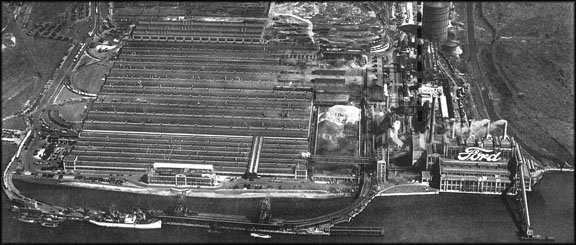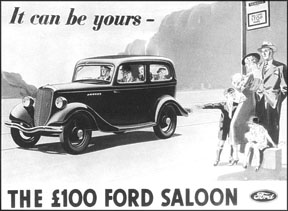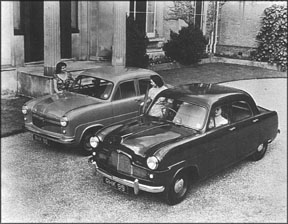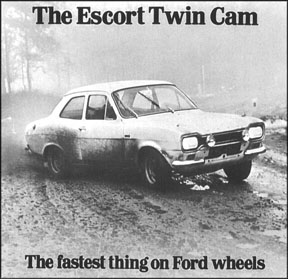A Brief History of Ford of Britian

Dagenham works circa 1953
In the late Twenties, Henry Ford and Percival Perry created the "1928 Plan" which gave Ford Ltd a 51% ownership of all of Ford's European subsidiaries. The plan was that Ford Ltd would build a huge plant, patterned after the Rouge in Dearborn, at Dagenham on the north shore of the Thames. From here Ford Ltd was to build cars not only for the British market, but kits for assembly through out Europe and all of the British Empire (through cooperation with Ford of Canada, which held the sales rights). European economic nationalism, in the face of the Great Depression, greatly blunted the 1928 Plan with Ford of Germany and France largely going their own way.
By the time the massive Dagenham complex opened in October 1931, Ford with in deep trouble with the unpopular Model A and was in serious need of a small car designed specifically for English and European conditions. With only a 10 month development program (based in Dearborn), production of the 933 cc Model Y Ford began in August 1932. The Model Y was designed by the talented Bob Gregory. When Edsel Ford saw the Model Y he asked Gregory to scale it up as the 1933 Ford Model 40 (V8). The Model Y, which celebrated its 75th anniversary in 2007, was a seminal Ford. It proved very popular, with demand for cars and export kits high enough to save Ford's massive Dagenham investment. It would not be an exaggeration to say that modern day Ford of Europe was built on the success of the Model Y.

1935 Ford Popular

1951 (Mk I) Ford Zephyr and Consul
After the War, Ford of Britain, like all of British industry was told to "Export or Die". And export they did, with an emphasis on the small Anglia and Prefect, the Fordson/Thames E83W van and Fordson tractors. In fact Dagenham exported its millionth car in 1955 (to Canada), this number was well over half of the total of 180,000,000 British Fords built since 1946 and represented a quarter of all British exports. Between domestic consumption and exports, during most of the 1950s Ford could barely keep up with demand and plant expansion was constant.
The Mk I Consul and Zephyr proved to be a landmark design both for Ford and the auto industry as a whole. These cars were the first Fords to feature a OHV engine, 12-volt electrics, strut front suspension, suspended foot pedals and only the second Ford (after the Lincoln-Zephyr) to use unit-body construction.
Late in 1962 Ford introduced the brilliant Cortina, an utterly conventional family car with enormous performance potential. The Cortina GT was a winner on the track wherever it was sold, and Cortina Lotus, introduced at the same time as Ford's commitment to "Total Performance" is now a racing legend.
During the 1960s Ford of Britain, with guidance of Walter Hayes, became a leader in motorsports. From Cortina victories in rallies like the African Safari, to the magnificent 1-2-3 victory of the Ford GT40s over Ferrari at LeMans in 1966 to the partnership with Cosworth in developing the winning DVF Formula 1 engines, Ford of Britain seemed to be at its zenith.
In 1967, Henry Ford II merged all of Ford's European companies in to a single Ford of Europe organization (Ford USA having taken complete financial control of its European subsidiaries in the early Sixties). It took ten years to commonize most of the product line between England and Germany, but by 1980 the transition was basically complete. While Ford's British operations were once massive and varied, ranging from heavy truck production at Southampton to Ford's legendary AVO performance division at Aveley, and motorsports facility at Boreham, over the past 30 years, British operations have been shut down or transferred to the Continent. The last Blue Oval badged car to be built in England was a Fiesta which rolled out of Dagenham in 2002. Some Transit vans are still built in Southampton, though most are now built in Turkey. Ford's big Halewood plant was turned over to Jaguar in 2000. The Dagenham plant, now much smaller than in its heyday, currently produces tooling and a common- rail diesel engine, in partnership with Peugeot.
Ford continues to be a top selling brand in Britain and the Ford Motor Company still has a lot of investment there, but most of that activity is now in the form of component manufacturing and, of course, the non-core brands of Jaguar and Land Rover (soon to be sold).

1968 (Mk I) Escort Twin-Cam

Article provided by The International Ford History Project
